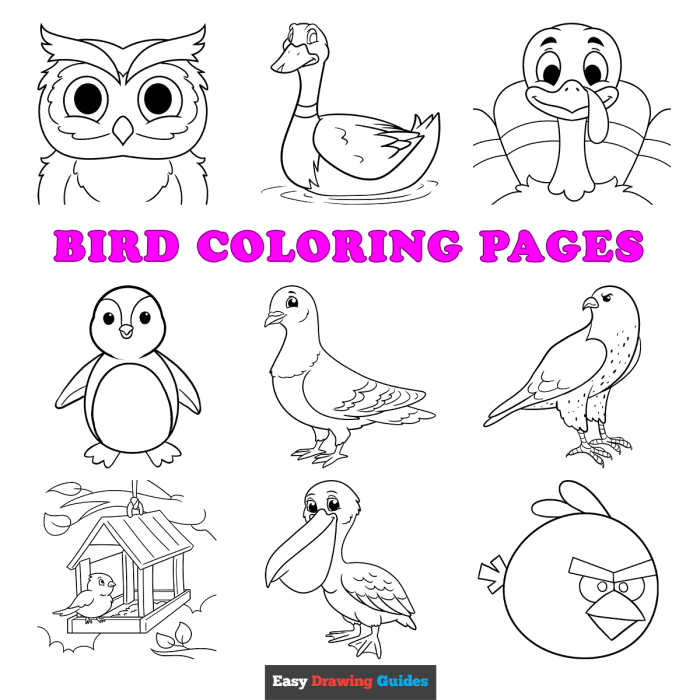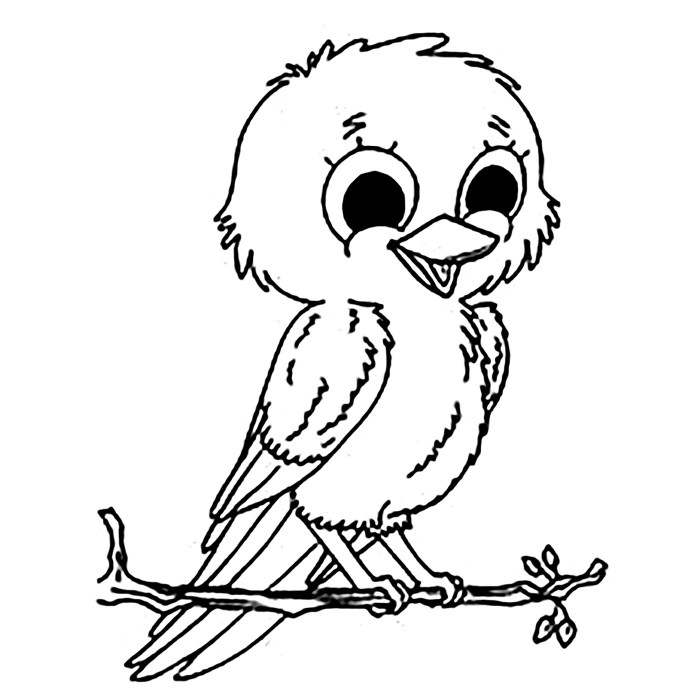Coloring Page Layout and Structure

Animal face coloring simple bird – This section details the design and implementation of a responsive HTML table-based layout for a bird face coloring page, featuring four distinct bird faces arranged for optimal visual appeal and efficient use of space. The goal is to create a coloring page that is easily printable and adaptable to various screen sizes.This design prioritizes a clean, uncluttered layout that is both visually engaging and practical for users of all ages.
The use of a responsive HTML table ensures the page adapts gracefully to different screen resolutions and devices, from large desktop monitors to smaller tablets and smartphones.
Simple bird face coloring pages offer a delightful introduction to the world of animal art for young children. These designs often feature large, easily colored areas, perfect for developing fine motor skills. For a broader selection of animal-themed activities, you might want to explore the extensive collection of animal coloring worksheets for kids , which includes many more options beyond just birds.
Returning to bird face coloring, the simplicity of the design makes it an ideal starting point for budding artists.
Responsive HTML Table Structure
The coloring page will utilize a 4-column HTML table to display the four bird faces. Each cell in the table will contain a single bird face image, ready for coloring. The table’s responsive design will ensure that the layout adapts to different screen sizes, maintaining a visually pleasing arrangement. Here’s the HTML code: <table style="width:100%;"> <tr> <td><img src="bird1.png" alt="Bird Face 1" style="width:100%; height:auto;"></td> <td><img src="bird2.png" alt="Bird Face 2" style="width:100%; height:auto;"></td> <td><img src="bird3.png" alt="Bird Face 3" style="width:100%; height:auto;"></td> <td><img src="bird4.png" alt="Bird Face 4" style="width:100%; height:auto;"></td> </tr></table>This code creates a table that takes up the full width of the screen.
Each table data ( <td>) element contains an image of a bird face. The style="width:100%; height:auto;" ensures that the images scale proportionally to fit within their cells, maintaining aspect ratio and preventing distortion. The alt attribute provides alternative text for screen readers. Remember to replace `”bird1.png”`, `”bird2.png”`, `”bird3.png”`, and `”bird4.png”` with the actual filenames of your bird face images.
The images should be pre-designed line art suitable for coloring. For example, “bird1.png” might depict a simple robin’s face with large, expressive eyes and a small, slightly open beak; “bird2.png” could be a parrot’s face with a more curved beak and detailed feathers; “bird3.png” might feature an owl’s face with large round eyes and prominent ear tufts; and “bird4.png” could be a more stylized hummingbird face with long, thin beak.
Bird Species Representation

Selecting appropriate bird species for simplified coloring pages requires careful consideration of their facial features. The goal is to choose birds with distinct, yet easily replicable, facial characteristics suitable for young children to color. Three species that meet these criteria are the owl, the robin, and the cardinal.
Owl Facial Features
Owls possess easily identifiable facial features that lend themselves well to simplification. Their large, round eyes are a prominent feature, often dark in color and set within a circular facial disc of feathers. This disc, often lighter in color than the rest of the plumage, frames the eyes and gives the owl its characteristic “face.” The beak is short, hooked, and relatively small compared to the size of the eyes and facial disc.
Simplifying an owl’s face for a coloring page would focus on these three key elements: the large, round eyes, the circular facial disc, and the small, hooked beak. These features can be represented with simple shapes and minimal detail, making them accessible for young artists.
Robin Facial Features
Robins, in contrast to owls, have a more streamlined facial structure. Their eyes are smaller and darker, often appearing as simple black dots. The beak is relatively slender and pointed, a characteristic feature for foraging insects. The most distinctive facial feature is perhaps the orange-reddish breast, which extends slightly onto the face, creating a subtle color contrast around the beak and eyes.
For a simplified coloring page, the focus would be on the small, dark eyes, the pointed beak, and the subtle orange-reddish wash on the face. The simplicity of these features allows for easy replication with basic shapes and colors.
Cardinal Facial Features
Cardinals, like robins, have relatively simple facial features. Their beak is conical and strong, ideal for cracking seeds. The eyes are small and dark, similar to the robin. However, the cardinal’s most striking feature is its bright red plumage, which extends across the face. A simplified design would emphasize the bright red color, the small, dark eyes, and the strong, conical beak.
The bold color contrast between the red feathers and the dark eyes provides a visually appealing and easily reproducible design.
Comparison of Facial Features, Animal face coloring simple bird
Comparing the three species reveals both similarities and differences crucial for design purposes. All three possess relatively simple eye shapes—small, dark, and roundish. However, the beak shapes differ significantly: the owl’s is hooked, the robin’s is pointed, and the cardinal’s is conical. The most significant difference lies in the overall facial structure and surrounding plumage. The owl’s large facial disc contrasts sharply with the streamlined faces of the robin and cardinal.
This variation in facial structure allows for diverse design approaches, offering different levels of complexity for coloring pages targeted at various age groups. The differences in beak shape and the presence or absence of a prominent facial disc provide opportunities to create unique and recognizable designs for each bird species.
Educational Aspects of Bird Coloring Pages: Animal Face Coloring Simple Bird

Coloring bird faces, while seemingly a simple activity, offers a surprising range of educational benefits for children, impacting both their cognitive development and fine motor skills. The engaging nature of coloring fosters a positive learning environment, making it an effective tool for introducing children to the fascinating world of ornithology.Coloring pages featuring simple bird designs can significantly contribute to a child’s cognitive development.
The act of choosing colors, coordinating them, and staying within the lines enhances hand-eye coordination and improves focus and concentration. Furthermore, the process of recognizing and differentiating various bird species through their unique features, like beak shape or plumage color, strengthens observational skills and memory retention.
Cognitive Development and Fine Motor Skills Enhancement
The repetitive motions involved in coloring help children develop fine motor skills crucial for writing, drawing, and other essential tasks. The act of gripping a crayon or colored pencil, controlling pressure, and coordinating hand and finger movements improves dexterity and strengthens hand muscles. Simultaneously, choosing colors and deciding how to fill in the bird’s face encourages creativity and problem-solving skills.
For example, a child might choose vibrant colors to depict a brightly colored parrot, while opting for more muted tones for a less flamboyant bird like a brown owl. This decision-making process, even in a simple activity, encourages critical thinking.
Bird Identification and Habitat Education
A simple bird coloring page can be a springboard for learning about different bird species and their habitats. For instance, a coloring page featuring a robin can be accompanied by information about its red breast, its preference for earthworms, and its typical nesting locations in gardens or trees. Similarly, a coloring page with an arctic tern could introduce children to the concept of migration and the bird’s unique adaptations for survival in cold climates.
Such activities integrate visual learning with factual information, making the learning process more engaging and memorable.
Activity to Enhance Learning
After coloring a bird, children can create a small “bird habitat” using readily available materials. This could involve constructing a miniature nest from twigs and leaves, or designing a simple landscape with rocks, small plants, and other elements representative of the bird’s natural environment. This activity not only reinforces learning about the bird’s habitat but also promotes creativity, problem-solving, and hands-on learning.
For example, a child coloring a hummingbird might then create a miniature garden with bright flowers, reflecting the bird’s diet and preferred habitat. This multi-sensory approach enhances comprehension and retention.
FAQ Explained
What type of paper is best for these coloring pages?
Heavier weight paper, such as cardstock, is recommended to prevent bleed-through, especially with markers or watercolors.
Can I adapt these designs for older children?
Yes, older children could add more detail, shading, and background elements to the designs.
Are there any safety considerations when using these coloring pages?
Always supervise young children while they are using coloring materials to prevent accidental ingestion or injury.
